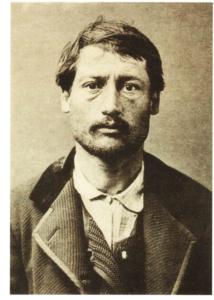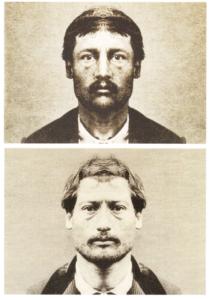From: PSYCHOBOX‚ A BOX PSVHOLOGICAL GAMES. Edited by: Mel GOODING. Shambala Publication . 2004
PHYSIOGNOMIES (1)
The common idea of the human face as revelatory of its owner's type and character was taken up by 19th century psychologists and regarded as especially valuable in the identification of criminal. psychopathic and neurotic personalities. This pseudo-scientific enthusiasm might have been tempered by the recollection of Duncan's salutary observation in Macbeth: . There's no art/To find the mind's construction in the face.' As it was‚ however‚ theorists and experimentalists confidently published physiognomic field-guides‚ and photography was quickly enlisted to present categorical arrays of facial types. Clinicians and policemen alike used these 'anthropometric' albums to help identify the latent tendencies of patients and suspects‚ (As mugshots and passport photographs universally attest. it is not difficult to make the most intelligent. harmless and sane of us look irremediably stupid‚ wicked or mad.)
People's faces are much more asymmetric than we think‚ Card 29 shows two composite faces constructed by taking each side of the original face and joining it with its mirror image‚
Before you continue‚ look at the 'real' face and then at the composites. Which of the laller looks more like the original? Chances are that you will pick that based on the left side (i‚e. left from your viewpoint).

PHYSIOGNOMIES (2)
Research shows that in judging identity or personal/physical similarity we tend to rely more heavily on information from the left side of someone's face (as we see it i.e. their right side). You can test this by viewing the 'real' face in a mirror: you will now most likely see the other composite as more similar.
Why is this so? It may be that more personal identity information is contained in the right side of a face (left side as we see it) - in fact most faces are wider on the right side - and that we attend more to that side‚ but research on where we focus most when looking at a face has not been conclusive. A different account emphasizes that in most people the right hemisphere of the brain seems more specialised for facial recognition. If you focus on the centre of a face without moving your eyes‚ the neural pathways from the eyes project what is to the left of your visual field to the right hemisphere first (and vice versa)‚ and that side of the face would reach the area specialised for face recognition more quickly‚ and dominate in recognition. But in fact we don't normally look only at the Centre of a face: our eyes move about. and information from each side reaches both cerebral hemispheres within moments.
Perceptual asymmetries also extend to our emotional responses. The right side of the brain is thought to dominate in our analysis of emotion and our expression of feelings. One might think that this would ensure that we also rely more on the right side of other people's faces (the left from our viewpoint) when judging their emotion. But if the right hemisphere has greater control over emotional expression‚ then‚ because our right brain controls our left side‚ it must be the left side of our face that expresses it more. And when we look at the left side of a face we are looking of course at its owner's right side: in which case it wouldn't make sense to rely on that side to judge emotions. Research is inconclusive on this issue‚ and there is as yet no consensus on the explanation(s) for asymmetries in face perception.
